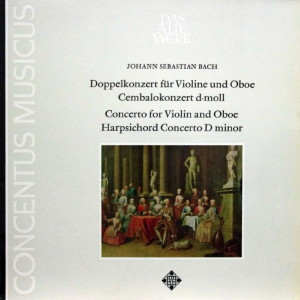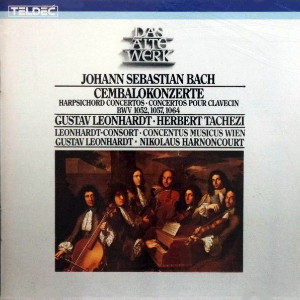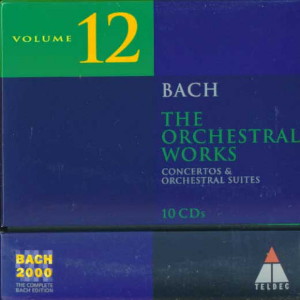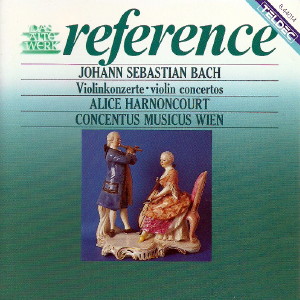 |
1 LP -
SAWT 9557-B - (p) 1970
|
 |
| 1 CD -
8.43116 ZK - (c) 1984 |
 |
| 10 CD -
3984-25717-2 - (c) 1999 |
 |
| 1 CD -
8.44019 ZS - (c) 1988 |
|
| Johann
Sebastian Bach (1685-1750) |
|
|
|
|
|
|
|
Sinfonia
aus dem Konzert D-dur, (Fragment) BWV
1045
|
|
6' 55" |
A1 |
| für
Solo-Violine, 3 Trompeten, Pauke, 2
Oboen, Streicher und Cont. |
|
|
|
| Konzert
für Violine und Oboe d-moll, BWV 1060 |
|
13' 28" |
A2 |
- Allegro
|
5' 11" |
|
|
| - Adagio |
4' 34" |
|
|
- Allegro
(Komponiert in Leipzig, 1730)
|
3' 43" |
|
|
| Cembalokonzert
d-moll (Concerto I, D minor), BWV 1052 |
|
21' 45" |
B |
| "Cembalo
(con)certato, due Violini, Viola e
Cont." |
|
|
|
- Allegro
|
8' 05" |
|
|
| - Adagio |
6' 02" |
|
|
| - Allegro |
8' 02" |
|
|
|
|
|
|
Alice Harnoncourt,
violin
|
|
Jürg Schaeftlein,
oboe
|
|
Herbert Tachezi,
harpsichord
|
|
|
|
CONCENTUS MUSICUS WIEN (mit
Originalinstrumenten)
|
|
-
Josef Spindler, clarino trumpet
in D
|
-
Wilhelm Mergls, Baroque violin |
|
| -
Günter Spindler, clarino trumpet
in D |
-
Walter Pfeiffer, Baroque violin |
|
| -
Hermann Schober, clarino trumpet
in D |
-
Josef de Sordi, Baroque violin |
|
| -
Kurt Hammer, Baroque timpani |
-
Stefan Plott, Baroque violin |
|
| -
Jürg Schaeftlein, Baroque oboe |
-
Kurt Theiner, Baroque violin |
|
| -
Karl Gruber, Baroque oboe |
-
Nikolaus Harnoncourt, Baroque
violoncello |
|
| -
Alice Harnoncourt, Baroque
violin |
-
Eduard Hruza, violone |
|
| -
Peter Schoberwalter, Baroque
violin |
-
Herbert Tachezi, harpsichord |
|
|
|
| Nikolaus
Harnoncourt, Leitung |
|
|
Luogo
e data di registrazione
|
| Vienna (Austria) - marzo e
settembre 1969 |
|
Registrazione
live / studio
|
| studio |
Producer
/ Engineer
|
Wolf
Erichson
|
Prima Edizione CD
|
- Teldec "Das Alte
Werk" - 8.43116 ZK - (1 cd) 22'
00" - (c) 1984 - AAD - (BWV 1052)
- Teldec "Bach
2000" - 3984-25717.2 - (10 cd) - 7' 02"
- (c) 1999 - ADD - (BWV 1045)
- Teldec "reference" - 8.44014 ZS - (1
cd) - 72' 58" - (c) 1988 - AAD - (BWV
1060)
|
|
Prima
Edizione LP
|
Telefunken "Das
Alte Werk" - SAWT 9557-B - (1 lp)
- 42'
11"
- (p) 1970
|
|
|
Notes
|
All
three of the works of Bach
presented on this disc are
of somewhat obscure origin.
There is no exact versions
in this particular form of
the Double Concerto in D
minor for Oboe and Violin
BWV 1060. A copy of the
Harpsichord Concerto in D
minor does exist in Bach's
own handwriting, but is,
however, most probably an
arrangement of a violin
concerto that, according to
many musicologists, was non
composed by Bach as all.
Strangely enough the
authenticity of the fragment
- the movements from the
Concerto in D major BWV 1045
- is never questioned, but
so-one has yet found a
proper place for it. From
all this one might well
suppose that we have here
gug up a few lass doubeful
remains to satisfy the
demand for more "Bach." This
is however, by no means the
case - on the contrary, the
two D minor concertos are
among the most famous of all
Bach's instrumental works
despite theit apparently
uncertain origins.
To my mind any doubts cast
on the authenticity of the
Harpsichord Concerto
particularly are quite
misplaced. One has only to
consider its artistic
magnitude and compactness.
Are we not willing to credit
Bach with composing a work
that cannot be neatly
categorized or compared wich
others and one that breaks
woth convention? Perhaps his
genius was more original and
inventive than our petry
speculations would allow. It
seems to me that the only
un-Bach-like quality of this
work is its "originality"
and surely this is the very
feature most characteristic
of Bach. I, as ani rate, can
think of no known
contemporary of Bach's to
whom this work of it. even
if this work had been handed
down to us anonymous, I
would unhesitatingly name
mights be attributed, and
any unknown lesser composer
would certainly not have
benn capable Johann
Sebastian Bach as the only
possible author. - It may,
then, be assumed that this
is the arrangement of a
violin concerto from the
Cothern period.
The Double Concerto has come
down to us only in a C minor
arrangement for two
harpsichords. From a study
of the two solo parts one
may, with all certainty,
conclude that this work was
a concerto originally
written for two melody
instruments. The difference
between the two solo parts -
arpeggio figures exclusively
in this first, clear melodic
lines in the second - and
the frequent unison passages
of the first solo part with
the tutti violins lead to
the probably correct
assumptions that here we
have the missing Concerto
for Violin and Oboe listed
in the Breitkopf catalogue
as no. 1764. By transposing
the work back to D minor -
Bach always transposed his
harpsichord concerto
arrangements down a tone -
the arpeggio passages on the
violin (open A and E
strings) acquire a natural
technical facility. The
reconstructions of this
concerto that have bitherto
been available cannot, for
several reasons, be rights
in the first place the range
and technical capacity of
the baroque oboe have not
been considered, and,
secondly, several violin
arpeggi that Bach had turned
into typical harpsichord
figures have obviously not
been restored. For this
recording, therefore, we
have tried to achieve a new
reconstruction, wing as
models Bach's own
arrangements of other
concertos, in particular of
violin concertos where both
versions are extant. Without
any need for additional
"arranging" merely from the
technique of the
instruments, the solutions
presented themselves so
naturally that we believe we
have come very near to the
lost original.
Probably the most remarkable
work on this recording is
the concerto fragment - the
Sinfonia. Although the
actual end of it is missing,
it is virtually a complete
movement, after the grandly
constructed cadenza only a
brief tutti finale would
follow. We have not composed
a finale for it here, but
simply repeated the first
tutti passage. This movement
was most certainly the
introduction to a cantata
and not the first movement
of an instrumental solo
concerto. Apart from
frequently recurring tutti
passages of ascending and
descending sequantial
figures, the movement
consists almost entirely of
complicated harmonic
processes described by the
violin through continuous
arpeggio figures. These
arpeggi are written down as
chords, but in such a way as
to make quite clear the
exact order of the
individual notes and any
changes in that order - the
performer is not left to
improvise with them as will.
This central
harmonic-rhythmic procedure
in further underlined by the
strings, oboes and trumpets
with short interjected
motifs or changing block
chords. In the first two
solo passages quite simple
motifs become gradually more
concentrated through
repetition and halving of
note values. The structure
of the movement is easily
perceptible: as four points
tutti passages join up the
solos, in the solos there is
a constant flow of new
variations on the arpeggio
figure until finally, after
the fourth tutti, a broad
cadenza begins. Herr Bach
demands the most modern
bariolage technique (playing
high up on the lower strings
against open notes on the
upper strings). Almost a
quarter of the movement is
devoted to this remarkably
slowly developing cadenza.
The size of the orchestra
here corresponds as nearly
as possible to that which
Bach throughout his lifetime
was accustomed to having at
his disposal for concertante
music and, indeed,
presumably preferred. The
Cothen orchestra woth its to
six violins was just about
the same size as the
Telemann Collegium Musicum,
the orchestra with which
Bach performed his
instrumental music in
Leipzig. The natural balance
achieved with such an
orchestra, rendering
unnecessary any
manipulations by recording
technicians, demonstrates
quite plainly that its size
was not dictated by
necessity but was utterly
appropriate to this type of
music. No additional
microphones was used for the
solo harpsichord, and it is
certainly not drowned by the
strings. The dynamic effect
is, bowerer maintained:
solo-tutti - piano-forte, a
principle fundamental to the
form of the concerto. In the
Sinfonia, likewise, we can
hear the natural balance.
Such extreme dynamic
contrast as the frequent low
notes of the solo violin
against an orchestra
consisting of strings, 2
oboes, 3 trumpets and
timpani can only be
satisfactorily convenyed
when using period
instruments of copies.
Nikolaus
Harnoncourt
|
|
Nikolaus
Harnoncourt (1929-2016)
|

|

|
|